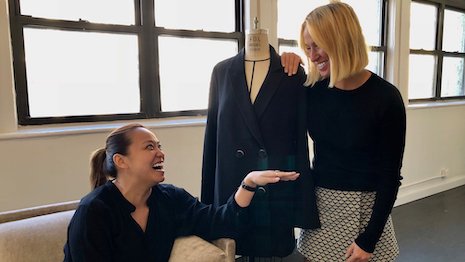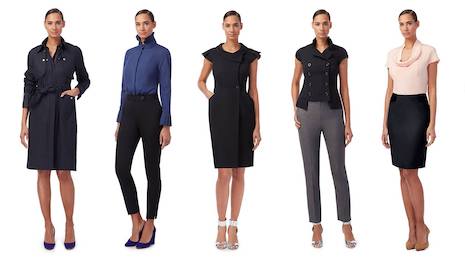 The RealReal focuses on sustainability through luxury consignment. Image credit: The Real Real
The RealReal focuses on sustainability through luxury consignment. Image credit: The Real Real
NEW YORK – A growing number of fashion companies are tackling sustainability issues head-on, as the industry continues to battle a reputation for being environmentally harmful.
During the “Future Friendly Wardrobe: Sustainability and Circularity in the Fashion Industry” panel at the Design Our Future conference on April 4, fashion insiders discussed how brands can be more environmentally-conscious. Emerging brands are focusing on strategies including reselling, limiting inventory and creating multifunctional items.
“We are huge believers in the circular economy,” said Allison Sommer, director of strategic initiatives at The RealReal. “How can we extend the life of luxury items?
“Not only is it a democratization of luxury and access, it also helps us get more value out of something that is already produced and had that [environmental] impact on the planet,” she said.
The Design Our Future conference was hosted by the United Kingdom’s Department for International Trade and the British Consulate General New York.
Sustainable strategies
Luxury resale on platforms such as The RealReal is one of the most accessible ways for consumers to lean into more sustainable shopping practices.
The fashion market category that relies on consigning high-end apparel and accessories is witnessing a period of enormous growth, outpacing the full-price segment of its industry by 20 percent, according to a report from Fung Global Retail & Technology. The entire resale industry is expected to grow from $18 billion in 2016 to $33 billion by 2021 (see story).
Misha Nonoo offers on-demand sustainable fashion. Image credit: Misha Nonoo
“The idea of resale is not new,” Ms. Sommer said. “It is the accessibility of it that we are excited to bring to a mainstream level.
“I don’t think we’re giving consumers enough credit,” she said. “People consign with The RealReal because of the environmental impact.”
In tandem with National Consignment Day, The RealReal launched its Sustainability Calculator to show how secondhand sales can have a positive effect on the planet. The platform’s calculations show that it has offset the equivalent of 65 million car miles in greenhouse gasses and energy saving since 2012 in regards to women’s apparel (see story).
While reselling reduces waste by extending the lifecycle of high-quality items, overstock poses another challenge.
“Excess inventory is one of the largest contributors to pollution,” said Lindsey Saletta, chief operating officer at Misha Nonoo, New York. “Extra product is not sustainable financially either.”
Swiss conglomerate Richemont and British fashion house Burberry are among the luxury companies that have recently come clean about destroying finished goods to prevent items from being sold in the “gray market,” a strategy used to avoid diminishing their brand and protect intellectual property (see story).
U.S.-based fashion label Misha Nonoo combats this issue by making all pieces made-to-order, reducing the amount of materials used and eliminating excess inventory. Currently, the brand has a turnaround time of two days before shipping out apparel.
“A sustainable business also has to be profitable,” Ms. Saletta said. “How do you create that sustainable business model that is scalable?”
Deploy London designs multifunctional womenswear. Image credit: Deploy London
British sustainable clothing brand Deploy London has a similar strategy to Misha Nonoo. Its clothing is multifunctional with ethically-sourced materials, and customers are encouraged to send items back if repairs are needed rather than disposing of the clothing.
“It is all about the people and how we can make clothing better,” said Dr. Bernice Pan, founder and creative director of Deploy London.
Beyond brands
As the sustainable fashion industry continues to evolve, panelists emphasized that more established brands need to take environmental responsibility as well.
“Fashion is paradoxical,” Dr. Pan said. “To make money, you have to make more products.”
According to the Responsible Luxury Initiative, companies should protect resources by using less and recycling more, using business strategies and philanthropic efforts to positively benefit society and being transparent about their progress to engage more investors and consumers.
Luxury fashion brands are encouraged to invest in the protection and restoration of crucial ecosystems. This will help keep raw materials, such as wool, leather and cotton, available for those same luxury retailers.
High-end brands can also use their influence to promote the development of more innovative and sustainable materials (see story).
While consumer choice has contributed to the growth of sustainable brands, regulation and customer education is also important.
For instance, New York City lawmakers have introduced anti-fur legislation that would ban the manufacturing and sale of animal pelts or apparel. There is recent precedent for citywide fur bans, with a fur ban going into effect in San Francisco earlier this year (see story).
“Existing large businesses are rather glacial in their approaches to sustainability,” Misha Nonoo’s Ms. Saletta said. “We have to create a cultural conversation around ‘less is more’ that happens around storytelling.”


